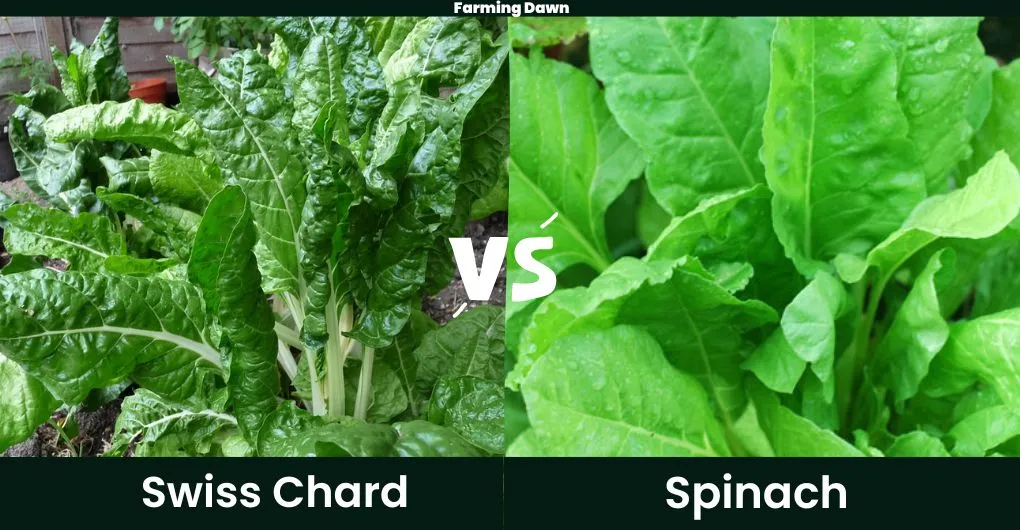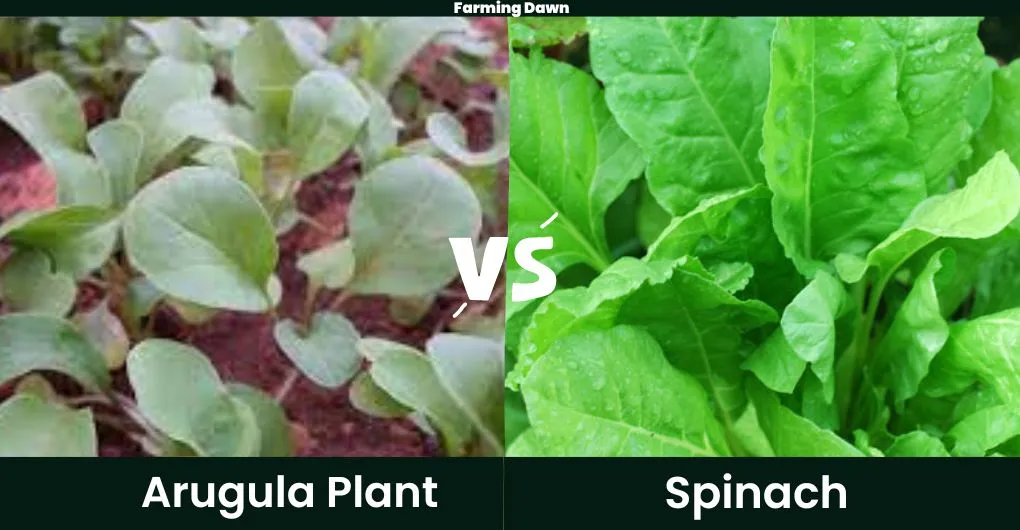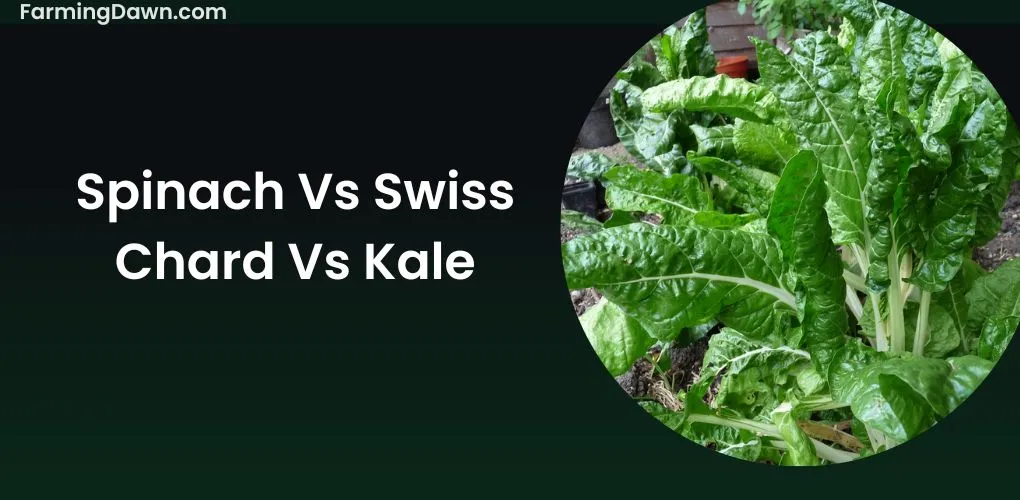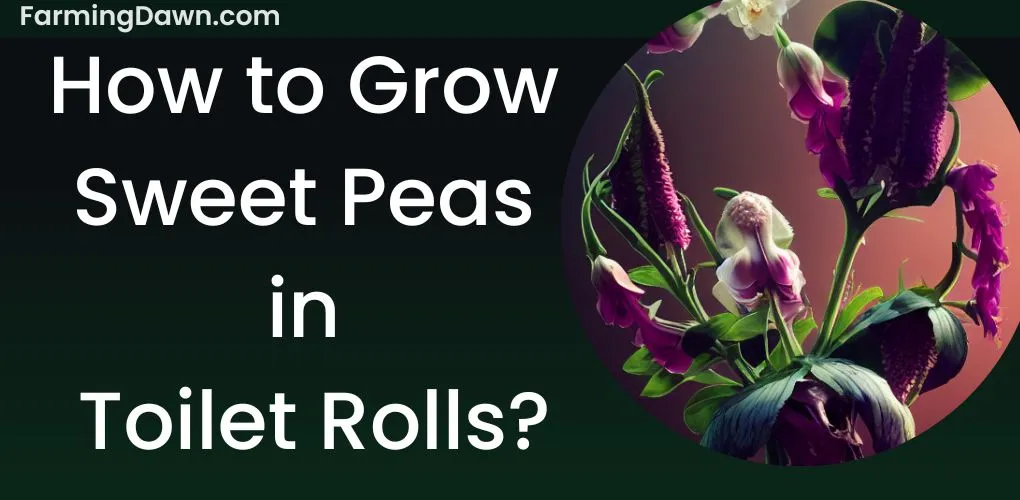If you’re looking to add some greens to your garden life, you may be considering either Spinach or Swiss chard. Both of these green vegetables are healthful and simple to grow, but they also differ in several important ways. I’ll compare spinach and Swiss chard in-depth in order to help you choose which is ideal for your garden.
Introduction to Spinach and Swiss Chard
Is Swiss chard and spinach the same thing?
No, Swiss chard and spinach are not the same things. Both spinach and Swiss chard are leafy green vegetables, however, spinach has smaller, crinkly leaves and thin stems whereas Swiss chard has larger, flat leaves. Additionally, they differ slightly in taste and texture, as well as in how they are utilized in cooking.

What is Spinach?
Spinach’s flavor is described as being slightly nutty and sweet. It is a tender, leafy, dark green vegetable. Smoothies, soups, salads, and sandwiches regularly use it. Additionally, it is an excellent supplier of vital nutrients. Because it is soft, spinach is easy to cook and eat.
What is Swiss chard?
Swiss chard, on the other hand, is a robust green with a more flavorful flavor and a crunchier texture. Due to its somewhat bitter flavor and chewy texture, it is a great substitute for hearty greens like kale. A popular addition to stir-fries, soups, and stews, Swiss chard is also a rich source of vitamins and minerals.
Similarities between Spinach and Swiss Chard
These two greens complement one another well in cooking and meal planning while having some apparent distinctions. They also share a number of similarities.
Nutrition
Both spinach and Swiss chard are great providers of iron, magnesium, potassium, vitamin K, vitamin A, and vitamin C. They are excellent additions to a balanced diet because they also contain antioxidants, fiber, and protein.
Taste
Both spinach and Swiss chard have a mildly earthy, slightly bitter flavor, while Swiss chard is typically regarded as gentler and sweeter. They are therefore an excellent accompaniment to savory foods like omelets, soups, and stews.
Appearance
Swiss chard leaves are broader and more crinkly than spinach leaves, which are normally tiny, delicate, and spherical. Both greens are healthy ingredients for cooking and feature vivid green leaves that are frequently used as beautiful garnishes.
Cooking
Swiss chard and spinach are both adaptable and can be prepared in a number of different ways, such as sautéed, boiled, steamed, or even raw in salads. For enhancing flavor and nutrients in smoothies and dips, both kinds of greens work fantastically.
Difference between Spinach and Swiss chard
The growing season is a prominent distinction between spinach and Swiss chard. Since spinach is a cool-season crop, it thrives in the cooler months of spring and fall.
On the other hand, Swiss chard, a warm-season crop, can withstand temperatures between the mid- and high-seventies. Swiss chard can continue to produce leaves in hot weather, but spinach will bolt (go to seed) and become bitter.
Planting
When it comes to planting, Swiss chard seeds are larger and require more space, but spinach seeds are smaller and can be put closer together. Swiss chard can grow up to 2 feet long, but spinach only gets to be approximately 6 to 8 inches tall.
Maintenance
Swiss chard and spinach both low-maintenance plants that require little irrigation or fertilizer. Swiss chard, on the other hand, is a hardier plant and can withstand less ideal growth circumstances than spinach, which is more delicate.
Growing Spinach and Swiss chard
The ideal growing conditions for spinach, a cool-season crop, are 40 to 75 °F. It does not endure the heat well and prefers damp, draining soil. After planting, the plant develops quite quickly and begins to make leaves in around 40–45 days.
Conversely, Swiss chard is a robust green that can survive greater temperatures and can be grown in either the chilly or warm seasons. It thrives on a range of sorts of soil and does best in well-drained, moist soil. The plant grows more slowly than usual, producing leaves in about 50–60 days.
When it comes to harvesting, spinach typically matures after approximately 45 days, whereas Swiss chard typically requires about 60 days.
However, Swiss chard is a more adaptable option for a long-term crop because you can keep harvesting leaves for a considerable amount of time.
Swiss chard vs Spinach Nutrition
Vitamins and Minerals
In addition to the vitamins and minerals iron and folate, spinach is a rich source of all three. Swiss chard, on the other hand, is a fantastic source of vitamins A, C, and K.
The potassium, magnesium, and manganese content is also high. Both spinach and Swiss chard are excellent providers of vitamins and minerals, although Swiss chard may be preferable for those who require more potassium and magnesium.
Antioxidants
Swiss chard and spinach both contain a lot of antioxidants, which shield our bodies from developing chronic diseases. Lutein and zeaxanthin, two antioxidants that are excellent for your eyes and support their health, are abundant in spinach.
However, Swiss chard has a lot of beta-carotene, a vitamin A precursor that is beneficial to your overall health.
Carbohydrates
In terms of calories and carbohydrates, spinach is superior to Swiss chard. Spinach is a low-calorie item that you may consume in huge quantities without putting on weight because it only contains 7 calories per 100 grams. On the other hand, Swiss chard has marginally more calories and carbohydrates (19 per 100 grams) (3.7 grams per 100 grams).
These nutritional values have been taken from the following sources:
Difference between chard and red
Chard and red chard are both varieties of the same plant, Beta vulgaris, which is part of the Chenopodiaceae family. The hue of the leaves is what distinguishes the two. While red chard has crimson leaves, chard has green leaves. Other than that, the taste and texture of the two varieties of chard are comparable and can be used interchangeably in recipes.
What is chard?
The same species as beets, chard is a lush green vegetable. Large, dark green leaves and juicy, tasty stalks in a range of hues, including white, yellow, and red, are its most distinctive features.
Is Chard good for you?
Yes, chard is a healthy vegetable that is thought to be good for your health. It has few calories and a lot of vitamins, minerals, and antioxidants, which makes it a good addition to a healthy diet.
For example, chard is a good source of vitamins, as well as minerals like magnesium and potassium. Below I have also compared their nutritional value in detail.
What is red chard?
Red chard also like chard or Swiss chard is a leafy green vegetable that belongs to the beet family. It has red stalks and veins and dark green leaves.
What is red chard good for?
The leafy green vegetable red chard is a good source of vitamins and minerals, as well as other essential elements. It is a beneficial complement to a balanced diet because it is low in calories.
Red chard may help with digestion, strengthen bones, and reduce your risk of contracting some chronic diseases.
What is red chard used for?
A frequent and wholesome element in cooking is red chard, a leafy green vegetable. It may be included into many meals, such as salads, soups, stews, sautés, and side dishes. Additionally, it can be incorporated into smoothies to provide nutrition.
Swiss Chard vs Spinach vs Kale
I have already compared the Swiss chard and spinach in the above segments. Now in this section, I will only compare spinach and Swiss chard(both of them) with Kale.
Nutrition
Kale’s flavor is a little bitter and a little sweet. However, when prepared properly, it can be wonderful. Some people find its flavor to be excessively strong. Smoothies, salads, and baked products frequently contain kale as an ingredient.
Taste
Foods that are high in nutrients include kale, which has a pleasant flavor. It has high levels of vitamins and minerals. Furthermore, it has a lot of protective elements.
Growth
The sturdy green kale thrives in cool climates and is cold-tolerant. Since it has a strong, slightly bitter flavor and a rough texture, it is frequently sautéed or massaged into salads.
Gardeners might consider growing kale because it is simple to cultivate and yields well.
My Take
Although each of these three leafy greens is rich in nutrients, it also offers its own combination of advantages and disadvantages. If you’re searching for a moderate, adaptable green that’s simple to use in a variety of recipes, spinach is a fantastic option.
If you want a flavor that is a little bitter but can be made more palatable by adding other ingredients, Swiss chard is an excellent option. If you’re looking for a green that is high in nutritional value, kale is a great option.
Arugula vs Spinach in Gardening
If you want to cultivate leafy greens in your yard, you might be debating between spinach and arugula. Although both greens are well-known for their distinct flavors and health benefits, each has certain advantages and drawbacks of its own.

Arugula
The spicy leafy green arugula, commonly referred to as rocket, is used frequently in salads and sandwiches. It is a fantastic choice for early spring or fall gardens because it is quite simple to grow and thrives in chilly climates.
Arugula is a low-maintenance choice because it is resistant to many common garden pests and illnesses.
Spinach
Contrarily, spinach is a sweeter and more adaptable green that is frequently used to salads, smoothies, and soups. It is equally simple to grow, but it does best in cooler climates, where it can get bitter and bolt (go to seed).
Due to its susceptibility to downy mildew and other fungal diseases, spinach requires a little more upkeep than other vegetables.
My Take
Arugula or spinach, which is best for your garden? Your unique interests and climate will determine the solution.
Arugula might be a better option for you if you want a low-maintenance green with a peppery flavor and live in a cooler area. Spinach might be a better option if you live in a warmer region, prefer a sweeter flavor, and want more variety.
Conclusion: Spinach vs Swiss Chard vs Kale
I hope that after reading all the detailed information above you have got your answer on spinach and Swiss chard and what is best for your garden, depending on the preferences of your climate.
So, whether you choose spinach or Swiss chard, you are making a good choice for your garden or even for your diet. Hope you liked this article. Thank you!
Each vegetable has different attributes and nutritional value. And each grows and harvests at their appropriate time. Read my other posts to learn more:






